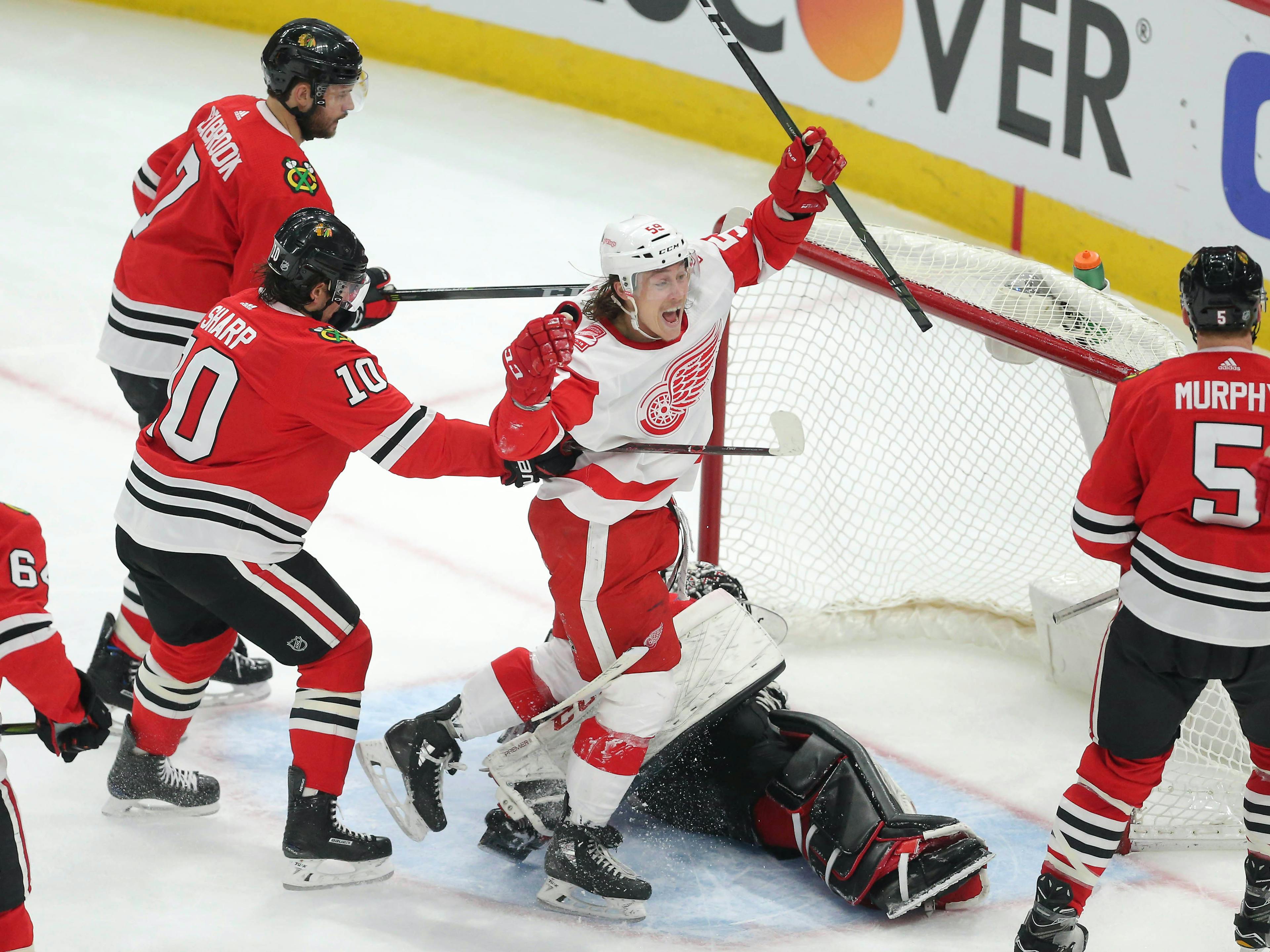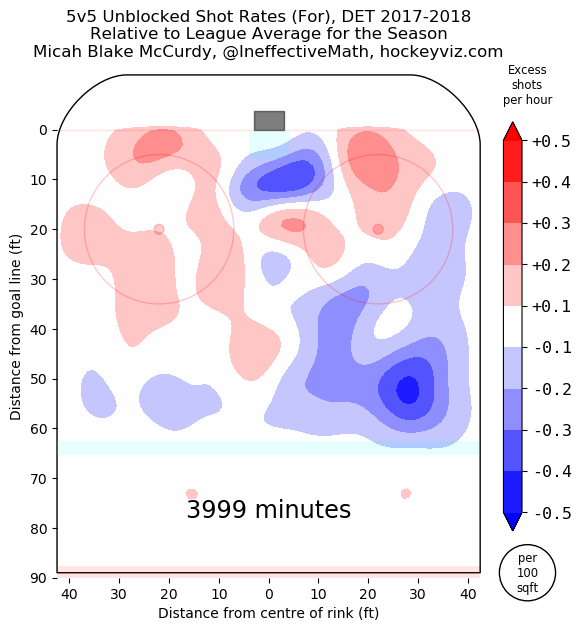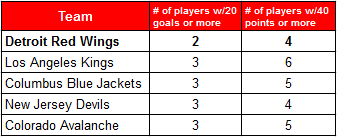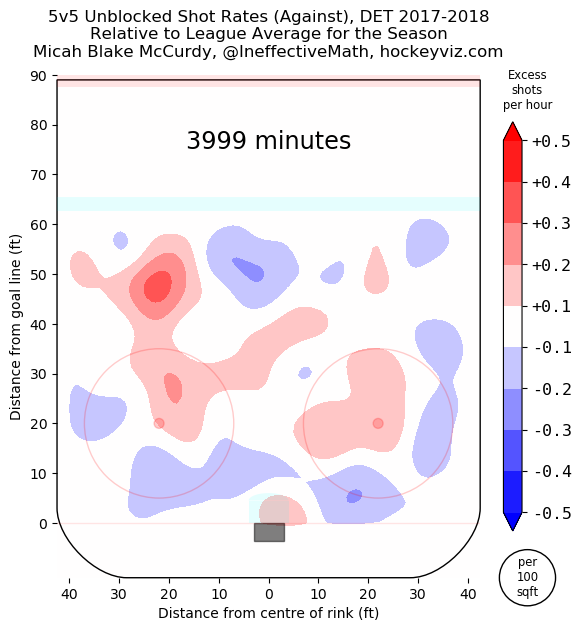Red Wings 2017-18 Season Review Part 1: Offense & Defense

By Nick Seguin
5 years agoWhen the regular season ended, I took some time away from the Red Wings. The hockey season can be a long one, especially when the team you cover is a basement dweller. I knew that a season review had to happen, but I didn’t want it to be written from an emotional place. After consuming myself in the interviews and press conferences from the team’s locker clean-out day, my head was spinning as I tried to piece together what happened this season and how the team takes a step forward next year.

Throughout the season, I was angry at Ken Holland and his roster moves; I was bewildered with Jeff Blashill and his process. All of this anger and frustration boiled over into a general apathy that wouldn’t allow me to evaluate this team and their season in a fair or rational manner.
So I took some time away from the team. I entrenched myself in the NHL playoffs, taking in every second of playoff hockey that I could. The tension was palpable; the intensity, refreshing.
It’s something that Hockeytown hasn’t seen in two years now and it’s made me realize how much I miss watching the Red Wings there. It piqued my curiosity — why weren’t they there? Suddenly, I found myself looking back over the 2017-18 season just to see: what went wrong? What went right?
This season review is going to be split into five sections and three parts. Part one will focus on offense and defense. Part two will zone in on goaltending and special teams. Finally, part three hands out individual awards to the team’s best players, as voted on by Wings Nation staff.
So grab a coffee, a stress ball, and let’s dig into the 2017-18 Detroit Red Wings regular season.
Before diving into the meat and potatoes of it all, let’s get one thing out of the way: this was a painfully disappointing season. Their 30-39-13 record was good for 73 points, fifth worst in the league and landing them an 8.5% chance of winning the draft lottery. With a 0.445 points percentage , it was the worst performance a Red Wings team has put up since a .438 points percentage in the 1989-90 season. It’s been twenty-eight years since the Red Wings have been this bad.
There’s a mixture of factors that contributed to this result, including streaky goaltending, a broken powerplay, and stretches of games without a defensive presence. For now, let’s start by looking at the offense.
Offense
I decided to evaluate the team’s offensive game through a myriad of lenses. Shots on goal and shot attempts dictate their possession game and how much time they’re spending in the offensive zone. Scoring chances tell us how dangerous they are with the puck. Goals, obviously, measure their scoring. Finally, I’ll look at where they are shooting from within the offensive zone.
All of the stats are adjusted 5-on-5 and from Corsica.hockey unless stated otherwise.

The first thing that jumped out at me here was that the Wings’ offense improved this year in all metrics. Their 48.74 Corsi-For percentage was below league average, but it was a whole point better than last year’s. It still ranked bottom third of the league, though. This lead to the team scoring more goals at 5-on-5.
The improvements were driven, unsurprisingly, by the young players. Only four forwards had a 5-on-5 CF% at 50% or higher. One of them, Evgeny Svechnikov, has too small of a sample size to really evaluate properly (though he had an impressive 12.76 iCF/60, which was 7th best on the team). That leaves Anthony Mantha, Dylan Larkin and Martin Frk. For the most part, the division of ice time among forwards reflected that, with Mantha and Larkin each getting more than 8% of the total 5-on-5 ice time for forwards. They were two of four forwards to receive that big of an allotment of ice time.
We’re all familiar with the impressive seasons Mantha and Larkin had, but Frk was a bit of a surprise here. Someone who was supposed to be a power play specialist quietly put up a modest 1.72 points-per-sixty-minutes at 5-on-5. This was better than Henrik Zetterberg, Gustav Nyquist, and Justin Abdelkader. Sure, his deployment slightly favoured the offensive zone (38.78 OZS% vs. 31.43 DZS%), but I wonder what more he could have offered if given the chance.
This improved shot attempt percentage led to a better shot percentage for the team as well. That being said, pure volume of shots does not mean they were good scoring chances. Six of the top-10 teams that took the most shots at 5-on-5 in 2017-18 missed the playoffs. Detroit was not even close to the top-10 in terms of shot volume. With 1,743 total shots at 5-on-5, the Wings ranked 25th in the league. To top it off, they were not getting shots off from quality areas on the ice. The following chart from hockeyviz.com shows just how poorly Detroit did at shooting from high danger scoring areas.

Detroit needs to do a better job of getting shots off in front of the net. That big blue circle right in front of the crease indicates they are losing net-front battles and mostly working the puck around the outside of the slot. The darkest shades of red on either side of the net at the goal line tell us that they are shooting far too much from those bad angles, where the goalie has his body tight against the post and the opposing team’s defensemen are clogging up the passing lanes.
The Wings obviously favour the left side of the ice for shots (that’s because 18 of their 23 regular roster players are left-handed), but take most of them from further out and a poor angle. They didn’t get much at all from their defensemen and that’s because they really only had one scoring threat on the back-end in Mike Green. He was heavily defended against in the offensive zone, as indicated by the big blue dot at the blue line on the right side.
These poor shot locations led to poor scoring chances. The Wings ranked 28th among all teams in 5-on-5 scoring chances, according to Natural Stat Trick. Their 47.83 scoring chances-for percentage was sixth worse in the league.
In terms of scoring, the Wings rocked an 8.02 shooting percentage at 5-on-5, which is floating with league average. The lack of goals all year was due to their suppressed shooting. Far too many times did the Wings cycle the puck in the offensive zone without getting a shot off. And they didn’t shoot because they couldn’t get the puck to the middle of the ice. Their 139 goals at 5-on-5 this year was a slight improvement over the 134 they had last season, but it was the 25th least amount of goals scored by a team in the league.
This is in part due to the massive amount of time spent in the defensive zone, but it’s also because of their lack of offensive talent. Larkin and Mantha led the team with 63 points and 24 goals respectively. Outside of these two, the Wings only had two other players record 40 points or more in Henrik Zetterberg and Gustav Nyquist. There was only one other player who scored 20 goals or more (Nyquist). This isn’t far off from this year’s four wild card teams.

That being said, each of those four teams had at least one player record more than 80 points (Colorado had two!) and three of the four had a 30 goal scorer.
And those are just the wild card teams, not the contenders.
Detroit’s offense, though improved over their last season, is still lacking when compared to the rest of the league. They have two big offensive gaps. The first is an elite goal scorer. Mantha should be able to crack the 30 goal milestone next season, something we haven’t seen a player do in Detroit since the 2008-09 season, but I’m not sure he’s an 80+ point kind of player. Larkin maybe is, but it’ll be tough to squeeze another 20 points out of him with the kind of defensive responsibilities he’s burdened with.
The second offensive gap is scoring depth. With shot attempt and shot for percentages under 50%, their bottom-6 is spending far too much time in their own zone defending rather than supporting with depth scoring.
Rating: C
Though the team’s offense showed some improvements over the 2016-17 season, they are far below league average and leave them at a loss when they are competing against the NHL’s best.
Defense
This was a part of the Red Wings game that was a bit daunting to look into. The blue line is very clearly their weakest link and I knew the results were not going to be pretty.
In evaluating the defense, I pulled the same stats as above for offense, but included the team’s save percentage.

As opposed to the offensive stats, which improved slightly year-over-year, the defensive stats got worse.
This really shouldn’t be a surprise to anyone. The Wings not only lack an elite number one defenseman, they lack any kind of top-2 talent on their blueline. Niklas Kronwall, now in the twilight of his career, is dealing with injury and waning ice time. Danny DeKeyser, once full of potential, seems to have hit his ceiling as a mid-pairing shutdown defenseman. Mike Green, though offensively potable, is past his prime and better suited for a special teams specialist role.
Only two Red Wings defensemen had Corsi-For percentages that were over 50% and they were the young ones. Nick Jensen (51.32% 5-on-5 CF%) and Xavier Ouellet (51.14% 5-on-5 CF%) had positive possession stats despite having a more defensive zone heavy deployment. Their possession rarely translated into points (Jensen had 15 and Ouellet had 7) and never into goals (both were scoreless all year).
The rest of the Red Wings defense had negative shot attempt percentages as they often collapsed in their own zone, trying to keep their opponents to the outside. It’s frustrating to watch the defense anchor themselves to the side of the net as opponents stick handle below the goal line and cycle the puck up the boards. They are not a very aggressive bunch and very slow on the transition.
As a collective, the Wings gave up 1847 shots at 5-on-5, which led to 167 goals against. Their lack of defensive pressure meant that teams were able to get these shots off from high-danger areas on the ice.

As the heatmap shows, the Wings allow a lot of shots from the left side of the goal. This is a side that’s defended by Justin Abdelkader, Anthony Mantha, and Andreas Athanasiou. A huge part of Jeff Blashill’s criticism of Mantha and Athanasiou was their defensive game and this chart reflects those concerns.
As for Abdelkader, the shutdown line that he was part of with Frans Nielsen and Darren Helm didn’t do too great of a job of shutting down. They had the third most time on ice of any trio in Detroit this season and had a 48.53 shot attempt percentage, allowing ten goals against while they were on the ice.
Another area of concern in the defensive zone are the red areas in the middle of the faceoff circles. These are a result of the Wings’ defensemen playing too far back and not challenging the puck holder enough.
Finally, the last area of concern is in the crease on the right side of the goal. This is way too dangerous of an area to be letting teams shoot from and it indicates a lack of aggression in clearing the front and sides of the net. It didn’t surprise me when I found out that Mike Green and Trevor Daley were most responsible for covering that side of the net.
The sheer volume of shots that got through was also due, in part, to the Wings’ lack of blocked shots. With 1168 blocked shots (or 14.2 per game played), they ranked 24th in the league in amount of shots blocked. The team leaders in this category were Trevor Daley and Danny DeKeyser, who blocked an average of 1.6 and 1.9 shots-per-game respectively.
The Wings could do a better job of getting in front of opponents’ shots, especially on the penalty kill, to better help out their goalies, who faced an average of 32.9 shots per game.
All of this leads to the conclusion that Detroit’s biggest issue is defense. The average age of their blueline was 30.86 with Ouellet clocking in as their youngest at 24 and Kronwall as their oldest at 37. I know that defensemen tend to hit their prime a little older, but four of the Wings core defensemen were 32-years-old or older.
They need an injection of youth, which will bring better skating and quicker transitions to the blueline. Nick Jensen is a good bottom-pairing defenseman, but he was arguably Detroit’s best defenseman last year. What does that say about the rest of them?
Rating: D
One of, if not the, worst D-corps in the league, there’s no doubt that this department needs a big overhaul. With Green likely gone this year and Kronwall’s contract expiring after next, they can turn the page on last season and focus on the future.
I hope you enjoyed part one of our 3-part 2017-18 season review. Let us know your thoughts on the Red Wings season in the comments section below and stay tuned for part two, which will feature goaltending and special teams.
Thanks to NHL.com, Corsica.hockey, hockeyviz.com, and NatStatTrick for providing all of the stats in this article.
Recent articles from Nick Seguin





